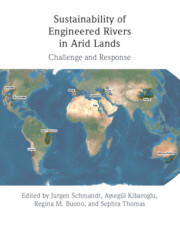Book contents
- Sustainability of Engineered Rivers in Arid Lands
- Sustainability of Engineered Rivers in Arid Lands
- Copyright page
- Dedication
- Contents
- Contributors
- Part I Introduction
- Part II Challenge
- Part III Engineered Rivers
- 7 The Nile River Basin
- 8 The Euphrates–Tigris River Basin
- 9 The Yellow River Basin
- 10 The Murray–Darling River Basin
- 11 The São Francisco River Basin
- 12 The Limarí River Basin
- 13 The Colorado River Basin
- 14 The Rio Grande / Río Bravo Basin
- 15 The Jucar River Basin
- Part IV Response
- Part V Conclusion
- Index
- References
9 - The Yellow River Basin
from Part III - Engineered Rivers
Published online by Cambridge University Press: 16 September 2021
- Sustainability of Engineered Rivers in Arid Lands
- Sustainability of Engineered Rivers in Arid Lands
- Copyright page
- Dedication
- Contents
- Contributors
- Part I Introduction
- Part II Challenge
- Part III Engineered Rivers
- 7 The Nile River Basin
- 8 The Euphrates–Tigris River Basin
- 9 The Yellow River Basin
- 10 The Murray–Darling River Basin
- 11 The São Francisco River Basin
- 12 The Limarí River Basin
- 13 The Colorado River Basin
- 14 The Rio Grande / Río Bravo Basin
- 15 The Jucar River Basin
- Part IV Response
- Part V Conclusion
- Index
- References
Summary
The Yellow River is by its nature not sustainable since it carried the world’s heaviest silt load for a long time. Yet, this silt load (loess plateau) has fallen considerably in recent years, but at the cost of other forms of sustainability, such as streamflow. The reasons for this dramatic decline in runoff are complex. In addition to reducing silt load, terraces and vegetation have led to the marked reduction in runoff. The fall in natural runoff can also be attributed to groundwater and mining extractions, as well as reservoir filling. Population per se is not a major driver of water demand compared to irrigated agriculture and other sectors, notably mining and industry. While China is not a federal system, it is organized in a complex hierarchical system where provinces play an important role and are capable of serving their own interests in negotiating usages and allocations of the river. The chapter analyzes peculiar physical conditions and water management institutions in the Yellow River Basin.
Keywords
- Type
- Chapter
- Information
- Sustainability of Engineered Rivers In Arid LandsChallenge and Response, pp. 107 - 120Publisher: Cambridge University PressPrint publication year: 2021
References
- 1
- Cited by



